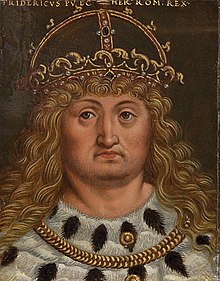Frederick the Fair
| Frederick the Fair | |
|---|---|

Frederick the Fair by Anton Boys
|
|
|
King of the Romans with Louis IV |
|
| Reign | 19 October 1314 – 13 January 1330 |
| Coronation | 25 November 1314 (Bonn) |
| Predecessor | Henry VII |
| Successor | Louis IV |
|
Duke of Austria and Styria until 1326 with Leopold I |
|
| Reign | 1 May 1308 – 13 January 1330 |
| Predecessor | Albert I |
| Successor |
Albert II Otto the Merry |
| Born | 1289 Vienna, Austria |
| Died | 13 January 1330 (aged 40) Gutenstein, Austria |
| Burial | Ducal Crypt (Vienna) |
| Spouse | Isabella of Aragon |
| Issue | Anna, Duchess of Bavaria |
| House | House of Habsburg |
| Father | Albert I of Germany |
| Mother | Elisabeth of Gorizia-Tyrol |
Frederick the Handsome (German: Friedrich der Schöne) or the Fair (c. 1289 – 13 January 1330), from the House of Habsburg, was Duke of Austria and Styria from 1308 as Frederick I as well as King of Germany (King of the Romans) from 1314 (anti-king until 1325) as Frederick III until his death.
He was born in Vienna, the second son of King Albert I of Germany by his wife Elisabeth of Gorizia-Tyrol, a scion of the Meinhardiner dynasty, and thereby a grandson of the first Habsburg king of Germany Rudolph I.
Still a minor, he and his elder brother Rudolph III had been vested with the duchies of Austria and Styria by their father in 1298. Upon Rudolph's early death in 1307 and the assassination of his father in 1308, he became the ruler of the Austrian and Styrian duchies on behalf of himself and his younger brothers. The royal title held by his father and grandfather however passed to Count Henry VII of Luxembourg, who was elected by six of seven votes, contrived by the mighty Archchancellor Peter von Aspelt, Elector and Prince-Archbishop of Mainz, a fierce opponent of late King Albert. Frederick had to abjure all claims to the German crown and in turn received the official affirmation of his fiefs by King Henry.
...
Wikipedia
